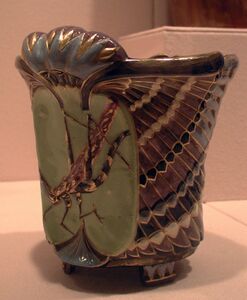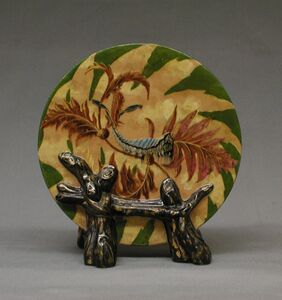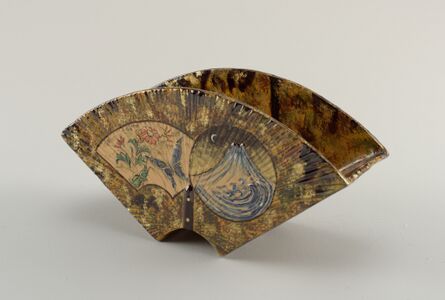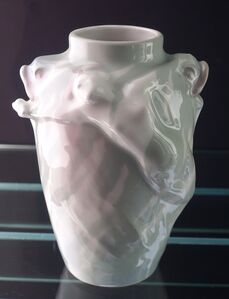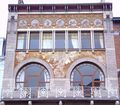آرت نوڤو
Clockwise from top left: Paris Métro station Abbesses, by Hector Guimard (1900); Lithograph by Alphonse Mucha (1898); Wall cabinet by Louis Majorelle; Interior of the Hôtel Tassel in Brussels, by Victor Horta (1892–1893); Lamp by Louis Comfort Tiffany (1900–1910). | |
| سنوات النشاط | ح. 1883–1914 |
|---|---|
| البلد | Western world |
أرت نوڤو ( Art Nouveau ؛ /ˌɑːr(t) nuːˈvoʊ/ AR(T) noo-VOH, بالفرنسية: [aʁ nuvo] (![]() استمع)؛ بمعنى "الفَنّ الجديد") هو أسلوبُ دوليُ مِنْ الفَنِّ والهندسة المعماريةِ والتصميمِ الذي بَلغ الذروة في الشعبيةِ في بِداية القرنِ العشرونِ (1880-1914) ويتمَيَّزُ بتصميماته المتُجَدَّدِة جداً، المتَدَفُّقة ، وتصميمات ذات خطوط منحنية وأشكال الأزهار والأشكال المستوحاة من النباتات.[1] Other characteristics of Art Nouveau were a sense of dynamism and movement, often given by asymmetry or whiplash lines, and the use of modern materials, particularly iron, glass, ceramics and later concrete, to create unusual forms and larger open spaces.[2]The style is known by different names in different languages: Jugendstil in German, Stile Liberty in Italian, Modernisme in Catalan, and also known as the Modern Style in English. It was popular between 1890 and 1910 during the Belle Époque period,[3] and was a reaction against the academic art, eclecticism and historicism of 19th century architecture and decoration.
استمع)؛ بمعنى "الفَنّ الجديد") هو أسلوبُ دوليُ مِنْ الفَنِّ والهندسة المعماريةِ والتصميمِ الذي بَلغ الذروة في الشعبيةِ في بِداية القرنِ العشرونِ (1880-1914) ويتمَيَّزُ بتصميماته المتُجَدَّدِة جداً، المتَدَفُّقة ، وتصميمات ذات خطوط منحنية وأشكال الأزهار والأشكال المستوحاة من النباتات.[1] Other characteristics of Art Nouveau were a sense of dynamism and movement, often given by asymmetry or whiplash lines, and the use of modern materials, particularly iron, glass, ceramics and later concrete, to create unusual forms and larger open spaces.[2]The style is known by different names in different languages: Jugendstil in German, Stile Liberty in Italian, Modernisme in Catalan, and also known as the Modern Style in English. It was popular between 1890 and 1910 during the Belle Époque period,[3] and was a reaction against the academic art, eclecticism and historicism of 19th century architecture and decoration.
One major objective of Art Nouveau was to break down the traditional distinction between fine arts (especially painting and sculpture) and applied arts. It was most widely used in interior design, graphic arts, furniture, glass art, textiles, ceramics, jewellery and metal work. The style responded to leading 19-century theoreticians, such as French architect Eugène-Emmanuel Viollet-le-Duc (1814–1879) and British art critic John Ruskin (1819–1900). In Britain, it was influenced by William Morris and the Arts and Crafts movement. German architects and designers sought a spiritually uplifting Gesamtkunstwerk ("total work of art") that would unify the architecture, furnishings, and art in the interior in a common style, to uplift and inspire the residents.[2]
The first Art Nouveau houses and interior decoration appeared in Brussels in the 1890s, in the architecture and interior design of houses designed by Paul Hankar, Henry van de Velde, and especially Victor Horta, whose Hôtel Tassel was completed in 1893.[4][5][6] It moved quickly to Paris, where it was adapted by Hector Guimard, who saw Horta's work in Brussels and applied the style to the entrances of the new Paris Métro. It reached its peak at the 1900 Paris International Exposition, which introduced the Art Nouveau work of artists such as Louis Tiffany. It appeared in graphic arts in the posters of Alphonse Mucha, and the glassware of René Lalique and Émile Gallé.
From Belgium and France, Art Nouveau spread to the rest of Europe,[بحاجة لمصدر] taking on different names and characteristics in each country (see Naming section below). It often appeared not only in capitals, but also in rapidly growing cities that wanted to establish artistic identities (Turin and Palermo in Italy; Glasgow in Scotland; Munich and Darmstadt in Germany), as well as in centres of independence movements (Helsinki in Finland, then part of the Russian Empire; Barcelona in Catalonia, Spain).
By 1914, with the beginning of the First World War, Art Nouveau was largely exhausted. In the 1920s, it was replaced as the dominant architectural and decorative art style by Art Deco and then Modernism.[7] The Art Nouveau style began to receive more positive attention from critics in the late 1960s, with a major exhibition of the work of Hector Guimard at the Museum of Modern Art in 1970.[8]
. . . . . . . . . . . . . . . . . . . . . . . . . . . . . . . . . . . . . . . . . . . . . . . . . . . . . . . . . . . . . . . . . . . . . . . . . . . . . . . . . . . . . . . . . . . . . . . . . . . . . . . . . . . . . . . . . . . . . . . . . . . . . . . . . . . . . . . . . . . . . . . . . . . . . . . . . . . . . . . . . . . . . . . .
التسمية
والاسم "أرت نوفو" إشتقَّ مِنْ اسمِ محل في باريس، بيت الفن الحديث، في ذلك الوقت و الذى كان يديره سيغفريد بنج، والذي قام بعرض أعمالَ إستلهمتْ من هذه المعالجةِ في التَصميم. الأرت نوفو حركة أثرت بشدّة على الفنانين و المعماريين و التى تتطورت لاحقاً في حركةِ ال(دي ستيل) (مِنْ 1880-1905) و مدرسة الباوهاوس الألمانية (أوائِل ثلاثيناتِ العشريناتِ).على خلاف الطرز الأخرى مِنْ التصميمِ، فأن الأرت نوفو كَانَ مُستَنَدَ واسعَ بما فيه الكفاية للإحاطة بكُلّ مناحى الحياة: فكان من الممكن العَيْش في بيتِ أرت نوفو بأثاثِ أرت نوفو، من فضيّات، و آنية فخارية، الخ.
الطراز الذى قدّمَه بنج لم يلاقى نجاحاً فورياً في باريس لكن بسرعة إنتشارَ إلى نانسي وإلى بلجيكا (خصوصاً بروكسل) حيث فيكتور هورتا وهنري فان دي فيلد قدّما مساهماتَ رئيسيةَ في مجال الهندسة المعماريةِ والتصميمِ. و في الأرت نوفو البريطانيِ شهد تطوّرَ أكثر للحركةِ في مجالات الحِرَفَ والفنونَ. و كان المركز الأكثر أهميةً في بريطانيا غلاسكو بما أبدعه تشارلز رينيه ماكينتوش.
و مع المحددات المحليةً بالنسبة لتلك الظاهرةِ وبالوعي الذاتي الراديكالي،و محاولة جعل القوالب أكثر أناقة تشكّلتْ بدايات الطرز المعاصرة (مودرنيزم) في القرن العشرون تَتضمّنُ (جوكنت ستيل) في ألمانيا، النمسا والعديد مِنْ البلدانِ الأخرى، أودا بولسكا (' بولندا الصغيرة ') طراز في بولندا، أَو السكونفيرك في الدنمارك، و الإنفصالية في فينا، حيث الفنانون والمصممون الباحثون عن التقدم أرادوا إنفصالا مِنْ معارضِ الصالونِ السائدةِ لعَرْض أعمالِهم الخاصِة بطريقة أكثرِ نسابة مع البيئة المحيطةِ ً.
في إسبانيا، الحركة تمُركزتْ في برشلونة وكَانتْ معروفة بالموديرنيزم، مَع المُصمّمِ أنتوني جاودى كالممارس الأكثر بروزاً. الأرت نوفو أيضاً ظهرت بقوة في أوروبا الوسطى وأوربا الشرقية، بتأثيرِ ألفونس موتشا في براغ و مورافيا (جزء من جمهورية التّشيك الحديثة) و لاتفية (ريغا، عاصمة لاتفيا، التى تستضيف أكثر من 800 مبنى للأرت نوفو).
المداخل إلى قطار الأنفاق في باريسِ التى صممها هيكتور جويمارت في 1899 1900 أمثلةَ مشهورةَ مِنْ الأرت نوفوِ في باريس.
تاريخ الأرت نوفو
بَلغَ الأرت نوفو الذروة في السَنَواتِ 1892 إلى 1902. فواحدة من أوّل صورِ الأرت نوفو يُمْكِنُ أَنْ تُوْجَدَ في قلعةِ روقيتيلات (فرنسا). أعادَ (فيوليت لو دك) القلعة في 1850، بالرغم من أنَّه كَانَ أكثر أعجاباً بأَنْ يصمم على طراز الإحياء القوطي.
التحركات الأولى ل"حركةِ" الأرت نوفو يُمْكِنُ أَنْ تميزها في فترة 1880، في حفنة من التصاميمِ التقدمّيةِ مثل المصممِ المعمارى آرثر ماكموردو عند تصميمه غطاءِ كتابِ لمقالتِه على كنائسِ مدينةَ السّيرِ كرستوفر ورين، نَشرَ في 1883. بَعْض أشغال الحديد المطاوعِ الأنسيابية مِنْ 1880 s يُمْكِنُ أَنْ تكُونَ مُقَدَّمة أيضاً، أَو بَعْض المنسوجِات ذات التصميمات (المشجّرة) ، والتى كانت ذات تأثير تحفيزى في أنماطِ التصميمِ الفيكتوريِ العاليِ.
أعلى المراحل في تطورِ الأرت نوفو كَانتْ في المعرض العالمى في 1900 في باريس، التي فيها إنتصرَ ' الطراز المعاصر ' في كُلّ الأوساط.و من المحتمل أن يكون وَصلَ لأوجَه ، على أية حال، كان هناك أيضاً المعرض الدولى لفن الزخرفة الحديثة في 1902 في تورين، إيطاليا، حيث قام بالعرض فيه مصممون مِنْ تقريباً كُلّ البلاد الأوروبية و التى أزدهر بها الأرت نوفو.
الأرت نوفو استعملَ العديد مِنْ الإختراعات التقنيةِ أواخر القرن التاسع عشرِ، خصوصاً الإستعمال الواسع للحديدِ المكشوفِ والكبيرِ، و قِطَعَ الزجاج المشكّلة بدون إنتظام في المعمار. و ذلك مع بدايةِ الحرب العالمية الأولى، على أية حال، طبيعة الطرز الغنية في تصميمِات الأرت نوفو —و التى كانت مكلفة جداً في أنتاجها —بَدأَ يصب في مصلحة العصرانيةِ المستقيمةِ الأكثرِ كفاءةً والتي كَانتْ أرخصَ في التكلفة وجعل الأفكار تَكُونُ أكثر إخلاصاً للجمال الصناعيِ البسيطِ الذي أصبحَ نواة فيما بعد لطراز الآرت ديكو.
الملامح الشخصية لطراز الأرت نوفو
الديناميكيا، والأشكال المتَمَوُّجة، والخطوط المتَدَفُّقة، وبالأقواس المختلفة ،و الخطوط ذات الإيقاعاتِ المتغيرةِ، كونتَ مُعظم شخصية الأرت نوفوِ. الميزّة الأخرى استعمالُ القطوع الزائدةِ والقطوع المكافئةِ. لتبدو القوالب التقليدية كأنما دبت فيها الحياة و نمت من أشكال النباتات.
ولأنها كانت حركة فَنِّية لَها صلاتُ مَع ما قَبْلَ الريفالتيس والحركة الرمزيّة، وفنانون مثل أوبري بيرتسلى، ألفونس موتشا، إدوارد برن جونز، غوستاف كليمت، وجان توورب و الذى يُمكنُ أَنْ يصنّفَ في أكثر مِنْ واحدة من هذه الطرز. على خلاف اللوح الرمزية،على أية حال، فالأرت نوفو لَهُ نظرة بصرية مُتميّزة؛ وعلى خلاف حركةِ الفنونِ و الحِرَفِ خلفيةِ المظهرِ (بالرغم من أنّهم ما كَانوا خلفيَين على الإطلاق)، استعملَ فناني الأرت نوفو و بسرعة موادَ جديدةَ ، سطوح مميكنة، والتجريدية و وظًّفوها في خدمةِ التصميمِ.
زهرية مِن قِبل داوم (c. 1900)
الكرسي صمّمَ مِن قِبل هنري فان دي فيلد لبيتِه "بلومنويرف" ببروكسل]].
"ماجوليكاهاوس" مِن قِبل أوتو واجنر
Ceramics
Glazed earthenware vase by Émile Gallé (1880–1885) (Metropolitan Museum)
Rookwood Pottery Company vase of ceramic overlaid with silver by Kataro Shirayamadani (1892)
- Grande Maison de Blanc Femme 2.JPG
Hand-painted tile panel on the facade of the Grande Maison de Blanc in Brussels (1897–98) designed by Privat Livemont and made by the Boch Frères Kéramis[9]
- Rippl-Rónai - Vase.jpg
Vase by József Rippl-Rónai (1900)
- Horti - Flower pot.jpg
Vase with vines and snails by Pál Horti (1900)
- Vase, modeled by Annie V. Lingley, Grueby Faience Company, Boston, c. 1901, glazed earthenware - Hood Museum of Art - DSC09245.JPG
Glazed earthenware pot by the Grueby Faience Company of Boston (ح. 1901)
- Bol art nouveau (Musée des arts décoratifs) (4714073425).jpg
Bowl by Auguste Delaherche (1901)
- No 29 Avenue Rapp entryway.jpg
Ceramic facade decoration of Lavirotte Building, Paris, by Alexandre Bigot (1901)
- Edmond lachenal ed émile decoeur, vaso, chatillon-sur-bagneux, 1902 ca..JPG
Vase by Edmond Lachenal (1902)
- Budapest Kozma utca Jüdischer Friedhof Schmidl Mausoleum 696.jpg
Zsolnay factory and Miksa Róth mosaics of Schmidl Mausoleum in Budapest (1902–03)
- Limoges enamel Art Nouveau Paul Bonnaud.JPG
Limoges enamel by Paul Bonnaud (1903)
- Grand hotel & la pace, vetrata di galileo chini in stile secessione, 1904 ca. 03.jpg
Ceramic tile façade decoration by Galileo Chini (1904)
- Turn-Teplitz - Vase with elm-leef blackberry.jpg
Amphora with elm-leaf and blackberry manufactured by Stellmacher & Kessner
- Fireplace mantel, attributed to Émile Müller, from Ivry-sur-Seine, circa 1904, glazed porcelain stoneware, inv. 2020.6.1 MAD Paris.jpg
Fireplace mantel attributed to Émile Müller (ح. 1904)
- Rookwood vase 2011.jpg
Rookwood Pottery Company vase by Carl Schmidt (1904)
- Azulejo Casa da Cooperativa Agrícola em Aveiro.jpg
Tile of Cooperativa Agrícola in Aveiro, Portugal (1913)
Ceramic art, including faience, was another flourishing domain for Art Nouveau artists, in the English-speaking countries falling under the wider art pottery movement. The last part of the 19th century saw many technological innovations in the manufacture of ceramics, particularly the development of high temperature (grand feu) ceramics with crystallised and matte glazes. At the same time, several lost techniques, such as sang de boeuf glaze, were rediscovered. Art Nouveau ceramics were also influenced by traditional and modern Japanese and Chinese ceramics, whose vegetal and floral motifs fitted well with the Art Nouveau style. In France, artists also rediscovered the traditional stoneware (grés) methods and reinvented them with new motifs.[10]
Émile Gallé, in Nancy, created earthenware works in natural earth colors with naturalistic themes of plants and insects. Ceramics also found an important new use in architecture: Art Nouveau architects, Jules Lavirotte and Hector Guimard among them, began to decorate the façades of buildings with architectural ceramics, many of them made by the firm of Alexandre Bigot, giving them a distinct Art Nouveau sculptural look.[10]
One of the pioneer French Art Nouveau ceramists was Ernest Chaplet, whose career in ceramics spanned thirty years. He began producing stoneware influenced by Japanese and Chinese prototypes. Beginning in 1886, he worked with painter Paul Gauguin on stoneware designs with applied figures, multiple handles, painted and partially glazed, and collaborated with sculptors Félix Bracquemond, Jules Dalou and Auguste Rodin. His works were acclaimed at the 1900 Exposition.
The major national ceramics firms had an important place at the 1900 Paris Exposition: the Manufacture nationale de Sèvres outside Paris; Nymphenburg, Meissen, Villeroy & Boch in Germany, and Doulton in Britain. Other leading French ceramists included Taxile Doat, Pierre-Adrien Dalpayrat, Edmond Lachenal, Albert Dammouse and Auguste Delaherche.[11]
In France, Art Nouveau ceramics sometimes crossed the line into sculpture. The porcelain figurine Dancer with a Scarf by Agathon Léonard, made for the Manufacture nationale de Sèvres, won recognition in both categories at the 1900 Paris Exposition.
The Zsolnay factory in Pécs, Hungary, was founded by Miklós Zsolnay (1800–1880) in 1853 and led by his son, Vilmos Zsolnay (1828–1900) with chief designer Tádé Sikorski (1852–1940) to produce stoneware and other ceramics. In 1893, Zsolnay introduced porcelain pieces made of eosin. He led the factory to worldwide recognition by demonstrating its innovative products at world fairs and international exhibitions, including the 1873 World Fair in Vienna, then at the 1878 World Fair in Paris, where Zsolnay received a Grand Prix. Frost-resisting Zsolnay building decorations were used in numerous buildings, specifically during the Art Nouveau movement.[12]
Ceramic tiles were also a distinctive feature of Portuguese Arte Nova that continued the long azulejo tradition of the country.
Mosaics
- Ivanovo Obl Vichuga asv2018-08 img02.jpg
Maiolica mural of Abramtsevo Colony in Russia (1870s–1890s)
- Wien - Majolika-Haus.JPG
Majolica House in Vienna by Otto Wagner (1898)
- Камин "Вольга Святославич и Микула Селянинович" в доме Бажанова.jpg
Majolica fireplace, house of Bazhanov, Abramtsevo Colony, by Mikhail Vrubel (1898)
- Mosaic in floor of entrance, Fox & Anchor Pub, 115 Charterhouse Street, London (8475013835).jpg
Mosaics of Fox and Anchor pub by William James Neatby in London (1898)
- Esslingen a.N. - Altstadt - Merkelsches Schwimmbad - Fassadenmosaik.jpg
Mosaics designed by Oskar Graf for Merkel’sches Schwimmbad in Esslingen am Neckar, Germany (1905–1907)
- S5000074a.jpg
Mosaics of Villa l'Aube by Auguste Donnay, in Liège, Belgium
- Church of the Holy Spirit 02.jpg
Mandylion by Nicholas Roerich in Talashkino, Russia (1908–1914)[13]
- Palatul Culturii din Târgu Mureș 20.jpg
Mosaics for Palace of Culture by Aladár Körösfői-Kriesch and Miksa Róth in Târgu Mureș, Romania (1911–1913)
- Park Guell Terrace.JPG
Trencadís mosaics in Park Güell by Antoni Gaudí in Barcelona (1914)
- Louis c. tiffany, paesaggio con giardino e una fontana, 1915 ca., 02.JPG
Mosaics by Louis Comfort Tiffany (1915)
Mosaics were used by many Art Nouveau artists of different movements, especially of Catalan Modernisme (Hospital de Sant Pau, Palau de la Música Catalana, Casa Lleó-Morera and many others). Antoni Gaudí invented a new technique in the treatment of materials called trencadís, which used waste ceramic pieces.
Colourful Maiolica tile in floral designs were a distinctive feature of the Majolica House in Vienna by Otto Wagner, (1898) and of the buildings of the works of the Russian Abramtsevo Colony, especially those by Mikhail Vrubel.
Textiles and wallpaper
- Wand Decoration Obrist 1895.png
Silk and wool tapestry design, Cyclamen, by Hermann Obrist, an early example of the Whiplash motif based on the stem of a cyclamen flower (1895)
- Nénuphar Verneuil Pl 2.jpg
Page on the Water Lily, from the book by Eugène Grasset on ornamental uses of flowers (1899)
- Kolo Moser - Abimelech - 1899.jpeg
Textile design by Koloman Moser (1899)
- Silverstudio.jpg
Printed cotton from the Silver Studio, for Liberty department store (1904)
- Vaszary János A pásztor szőnyeg 1906.jpg
The Shepherd tapestry by János Vaszary (1906) combined Art Nouveau motifs and a traditional Hungarian folk theme
- Horta Tapis KBS-FRB.jpg
A carpet by Victor Horta in the collection King Baudouin Foundation
Textiles and wallpapers were an important vehicle of Art Nouveau from the beginning of the style, and an essential element of Art Nouveau interior design. In Britain, the textile designs of William Morris had helped launch the Arts and Crafts movement and then Art Nouveau. Many designs were created for the Liberty department store in London, which popularized the style throughout Europe. One such designer was the Silver Studio, which provided colourful stylized floral patterns. Other distinctive designs came from Glasgow School, and Margaret Macdonald Mackintosh. The Glasgow school introduced several distinctive motifs, including stylized eggs, geometric forms and the "Rose of Glasgow".
In France, a major contribution was made by designer Eugène Grasset who in 1896 published La Plante et ses applications ornamentales, suggesting Art Nouveau designs based on different flowers and plants. Many patterns were designed for and produced by for the major French textile manufacturers in Mulhouse, Lille and Lyon, by German and Belgian workshops. The German designer Hermann Obrist specialized in floral patterns, particularly the cyclamen and the "whiplash" style based on flower stems, which became a major motif of the style. The Belgian Henry van de Velde presented a textile work, La Veillée d'Anges, at the Salon La Libre Esthéthique in Brussels, inspired by the symbolism of Paul Gauguin and of the Nabis. In the Netherlands, textiles were often inspired by batik patterns from the Dutch colonies in the East Indies. Folk art also inspired the creation of tapestries, carpets, embroidery and textiles in Central Europe and Scandinavia, in the work of Gerhard Munthe and Frida Hansen in Norway. The Five Swans design of Otto Eckmann appeared in more than one hundred different versions. The Hungarian designer János Vaszary combined Art Nouveau elements with folkloric themes.[14]
المتاحف
There are 4 types of museums featuring Art Nouveau heritage:
- Broad-scope museums (not specifically dedicated to Art Nouveau but with a large collection of items in this style). Art Nouveau monuments are italicised;
- House-museums of Art Nouveau artists (all but Alphonse Mucha museum are Art Nouveau monuments);
- Museums dedicated to local Art Nouveau movements (all are Art Nouveau monuments);
- Other Art Nouveau buildings with museum status or featuring a museum inside (not dedicated to local Art Nouveau movements/specific artists).
المجال الجغرافي للأرت نوفو
أبرز ممارسى الأرت نوفو
. . . . . . . . . . . . . . . . . . . . . . . . . . . . . . . . . . . . . . . . . . . . . . . . . . . . . . . . . . . . . . . . . . . . . . . . . . . . . . . . . . . . . . . . . . . . . . . . . . . . . . . . . . . . . . . . . . . . . . . . . . . . . . . . . . . . . . . . . . . . . . . . . . . . . . . . . . . . . . . . . . . . . . . .
في العمارة
بناية في ريغا مِن قِبل ميخائيل أيستشتاين
بيت المُصمّمِ بيتر بيهرنس
بناية مِن قِبل جوستاو لانداو جوديندغير
منزل في كيف مِن قِبل فلاديسلاف غوروديتسكى.
مبنى الإنشقاق فينا
- إيميليه أندريه (1871-1933)
- جافريل بارانوفسكى (1860-1920)
- بيتر بيهرينس (1868-1940)
- جورجيس بيت (1868-1955)
- بول تشاربونيير (1865-1953)
- أنتوني جاودى (1852-1926)
- هيكتر جيومارد (1867-1942)
- بول هانكر (1859-1901)
- جوزيف هوفمان (1870-1956)
- فيكتور هورتا (1861-1947)
- تشارلز رينيه ماكينتوش (1868-
- لويس سوليفان (1856-1924)
- يوجين فالين (1856-1922)
- هنري فان دي فيلد (1863-1957)
- أوتو واجنر (1841-1918)
- وليام وولكوت (1874-1943)
الجداريات والفسيفساء
- أنتوني جاودى (1852-1926)
- غوستاف كليمت (1862-1918)
- ألفونس موتشا (1860-1939)
- ميخائيل فروبل (1856-1910)
اقرأ أيضاً
- Aestheticism
- Art Nouveau in Milan
- Art Nouveau in Poland
- Art Nouveau religious buildings
- Belle Époque
- Fin de siècle
- Paris architecture of the Belle Époque
- Réseau Art Nouveau Network
- Secession (art)
- Second Industrial Revolution
- Timeline of Art Nouveau
- World Art Nouveau Day
- Art Deco
- طراز الحريَّةَ
ملاحظات
المراجع
- ^ Heilbrunn Timeline of Art History, Metropolitan Museum of Art, Art Nouveau
- ^ أ ب Sembach, Klaus-Jürgen, L'Art Nouveau (2013), pp. 8–30
- ^ Sterner (1982), 6.
- ^ Victor Horta Archived 19 أبريل 2019 at the Wayback Machine – Encyclopædia Britannica
- ^ World Heritage Centre, UNESCO. "Major Town Houses of the Architect Victor Horta (Brussels)". whc.unesco.org. Archived from the original on 13 May 2013. Retrieved 26 December 2019.
- ^ Oudin, Bernard, Dictionnaire des Architectes Victor Horta article
- ^ "Art Nouveau", Heilbrunn Timeline of Art History, Metropolitan Museum of Art
- ^ Vigne, Georges, Hector Guimard – Le geste magnifique de l'Art Nouveau, (2016), Editions du Patrimoine, Centre des Monuments National, p. 194
- ^ van Lemmen, Hans (2013). 5000 Years of Tiles (in الإنجليزية). The British Museum Press. p. 223. ISBN 978-0-7141-5099-4.
- ^ أ ب Riley 2004, pp. 314–15.
- ^ Edmond Lachenal and His Legacy, by Martin Eidelberg, Claire Cass, Hudson Hills Press; illustrated edition (25 February 2007)
- ^ Timeline Archived 19 أغسطس 2013 at the Wayback Machine, accessed 1/23/08
- ^ Journal of UralNIIProject RAASN – 2014. – № 2. – p. 27—32. – ISSN 2074-2932 (in Russian)
- ^ Riley 2004, p. 328.
وصلات خارجية
- Art Nouveau Teaching resource on the Art Nouveau movement from the National Gallery of Art in Washington, D.C.
- Réseau Art Nouveau Network, a European network of Art Nouveau cities
- Art Nouveau European Route, a non-profit association for the international promotion and protection of Art Nouveau heritage
- Europeana virtual exhibition of Art Nouveau
- Short description is different from Wikidata
- Articles containing ألمانية-language text
- Pages using Lang-xx templates
- Articles containing إيطالية-language text
- Articles containing قطلان-language text
- Articles with unsourced statements from December 2022
- Art Nouveau
- فن معاصر
- Architectural styles
- فنون زخرفية
- كلمات وعبارات فرنسية
- العصر الإدواردي
- حركات فنية
- طرز معمارية
- حركات معمارية
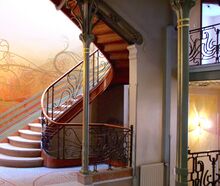
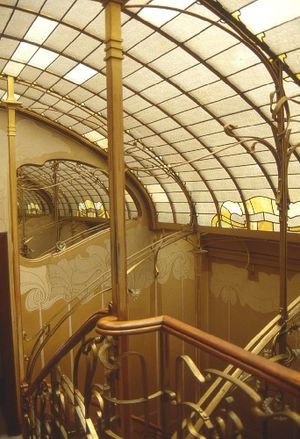
![الكرسي صمّمَ مِن قِبل هنري فان دي فيلد لبيتِه "بلومنويرف" ببروكسل]].](/w/images/thumb/2/28/Henry_van_de_Velde_-_Chair_-_1895.jpg/73px-Henry_van_de_Velde_-_Chair_-_1895.jpg)

